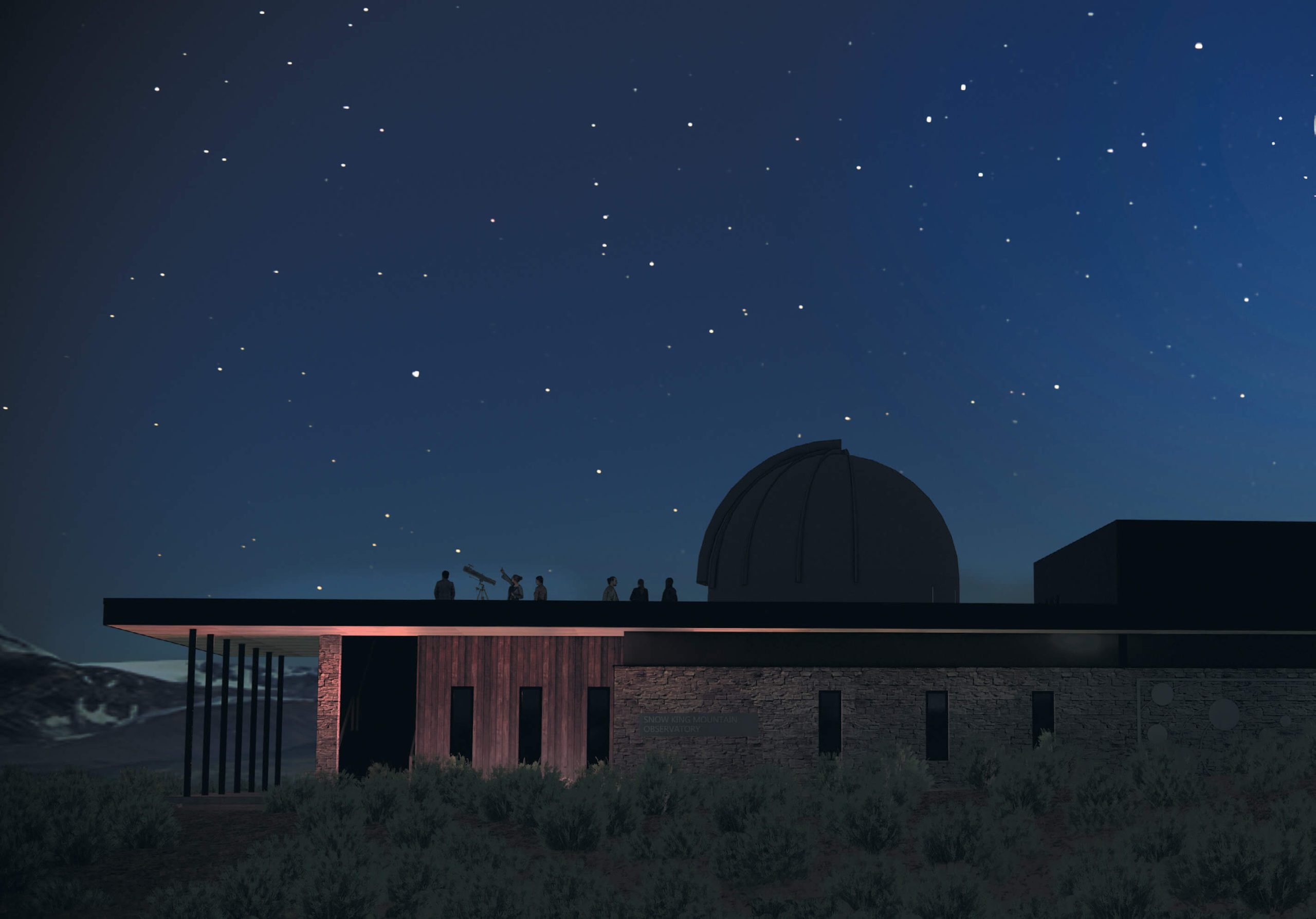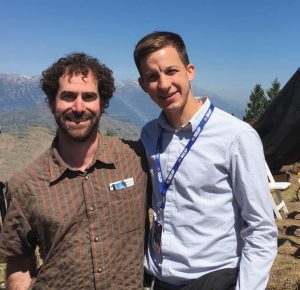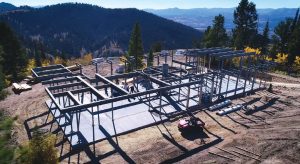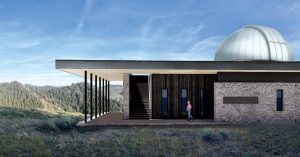
12 Apr The Snow King Observatory and Planetarium
Jakub Galczynski admits that he has been obsessed with buildings since sixth grade. Growing up in Chicago, the budding designer was surrounded by structures and public sculptures that engaged him, but he found he was lacking in inspiration. “I realized early on that most architects and artists are inspired by nature,” he says, adding that when the time came to pursue university-level education, the city boy gravitated to the country in search of profound experiences in nature. What he found changed him.

Galczynski (right) and astronomer Samuel Singer (left) have dedicated nearly a decade to the planning and design of the Snow King Observatory. | Courtesy of Jakub Galczynski
Located in Bozeman, Montana, Montana State University’s School of Architecture offers what Galczynski describes as a “really rare program where the community is immersed in nature.” Surrounded by sweeping mountain views and rural working landscapes, he enjoyed access to nature that, in turn, conditioned his profession.
Throughout Galczynski’s career, he’s developed a biophilic design approach that focuses on the relationship between humans and nature and how structures are inspired by place. In a full expression of this ethos, he is currently engaged in what he describes as the project of a lifetime: designing the Snow King Mountain Observatory and Planetarium at Snow King Mountain Resort in Jackson Hole, Wyoming. The project started as an ambitious vision by Samuel Singer, founder of Wyoming Stargazing, that Galczynski has since dedicated much of his life to. Currently under construction at the summit of Snow King Mountain, this space will serve as an educational center for the Rocky Mountain West where the public can learn about nature and gaze at the stars.
The Snow King project has a completion goal for fall 2023. The observatory will have a 24-foot rooftop AstroHaven dome and a 1.0-meter PlaneWave telescope designed specifically for ADA accessibility. The state-of-the-art telescope will be one of the world’s largest, dedicated primarily to public outreach. The facility will also include a Spitz 8-meter digital planetarium with a 37-seat capacity, a classroom and theater space with 40-seat capacity, galleries with interactive exhibits, and event space. Galczynski worked with Sedia Systems to design custom seating inspired by the surrounding dense lodgepole pine forest. Wyoming Stargazing, a nonprofit that helps educate the public about astronomy, estimates that the observatory could reach as many as 1 million students by 2030 through in-person and virtual programming.
While the observatory will raise the bar, its construction requires diverse collaboration. Galczynski is the lead designer for the project and is working closely with executive architect Jamie Farmer of Farmer Payne Architects in Wyoming as well as a number of skilled consultants, including structural engineer Jeffrey Hobson and the engineering team at Energy 1. “For the observatory and all its technical building plans, each piece has a carefully selected manufacturer, and all of it needs to be coordinated,” says Galczynski. The building system is very complicated, he continues, with considerations for the classroom, dome, planetarium, and telescope that are unique but also interactive. The team of architects, designers, consultants, and contractors must all work together to ensure functionality and that the “building reflects the values of a social space,” he says. “We designed it to be an iconic piece of Jackson, so when people are visiting Jackson, the astronomy observatory is on their list of things to do.”

Construction for the structure began in the fall of 2022 at the summit of Snow King Mountain. Slated for completion this fall, the observatory will include a rooftop dome and ADA-accessible telescope, as well as a 37-seat planetarium, 40-seat theater, and exhibit space. | Courtesy of Blake Cuilla Productions
After nearly a decade of extensive planning, 2022 ushered in the first steps of construction on the observatory, beginning with the pouring of the concrete foundation. It was a surreal moment for Galczynski and Singer, both co-founders of the observatory. “Samuel and I first started speaking about the observatory at a networking event in Jackson,” recalls Galczynski. “Samuel had this vision for an observatory, and I asked him, what if we made this beautiful observatory that people were attracted to visually? An observatory that goes beyond function to maximize its exposure to public education?”
That vision has manifested as a public celebration of what Galczynski sees as a more soulful and community-oriented space, something particularly unique to the Snow King project because of the location. When the observatory is complete, sky-gazers will be able to simply hop on the resort’s gondola to reach the observatory, which is poised at 7,808 feet above sea level. “It’s this big opportunity and something that was lacking in the astronomy community,” he says, explaining that observatories are often remote and have traditionally been functional spaces that are lacking in aesthetics. “They are built for the telescope and equipment,” he says. “I approached this from more architectural and aesthetic standpoints, and tried to look at the observatory as this public celebration — something that is super accessible.”
Galczynski says one of the touchstone structures that has guided the trajectory of his architectural career was John Carney’s Laurance S. Rockefeller Preserve Center in Grand Teton National Park, the first LEED-Platinum certified building within the National Park Service, recognized for its sustainability-focused design. “Yes, it’s functional, but Carney elevated the building to be a piece of architecture,” Galczynski says. “It inspires someone to really think about how we can respond more to the environment the building is in.”
Galczynski has pondered this relationship — the interaction between humans, structures, and the landscape — throughout his career. With a master’s degree in architecture, he’s held positions with firms based in Jackson, Bozeman, and Ketchum, Idaho. Primarily focused on residential design, Galczynski strategically worked for diverse teams that sculpted his knowledge of architectural concepts, aesthetics, and sustainability. He continuously admires Lindsey Love and Lindsay Schack of Love Schack Architecture, a team specifically focused on high-performance buildings and stringent passive-house design standards.
The Snow King Observatory fits into a theme Galczynski sees forming across the Intermountain West, or at least in the Northern Rockies triangle he’s been circulating since leaving Chicago. That trend, in simple terms, is embracing the capacity to be a backyard scientist and incorporating the expansiveness and vibrancy of the landscape into Western living. He says when you’re regularly surrounded by nature, it can be easy to become complacent, taking the grandeur of the world for granted. But, with educational centers like the observatory or the Laurance S. Rockefeller Preserve Center, which are places of learning that appeal to an aesthetic, people are reminded of the beauty around them. In particular, he references the Rocky Mountains’ starry skies. “It’s such a beautiful and major resource that we have. Because we live here, we often forget about that.”

This daytime rendering of the observatory, produced by Galczynski, illustrates the relationship between humans and nature and how structures might be inspired by place. | Courtesy of Jakub Galczynski
For Galczynski, the Snow King Observatory has become his opus, pushing design limits and his personal beliefs. “It’s not the same with residential projects,” he says. “They are ongoing and you get new projects every year. This, though, has occupied a third of my life.”
Tibby Plasse moved to Victor, Idaho sight unseen in 2009 and can’t find a good excuse to leave. A regular writer for the JH News and Guide, Teton Family Magazine, Western Home Journal, and other regional publications, she loves romping in the mountains with her son and bird dog no matter the season. Her podcast on biodynamic agriculture can be found at willforces.com.




No Comments